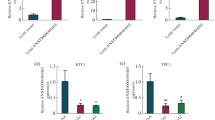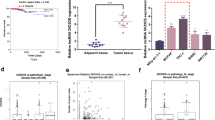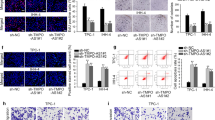Abstract
The purposes of this study were to investigate the potential roles of long noncoding RNA (lncRNA) PVT1 in thyroid cancer cell proliferation and to explore their possible mechanisms. A total of 84 patients who were diagnosed as having thyroid cancer (papillary thyroid carcinoma (PTC), follicular thyroid carcinoma (FTC), and anaplastic thyroid carcinoma (ATC)) in Renji Hospital were enrolled in this study. Expressions of lncRNA PVT1 in thyroid cancer tissues and cell lines (IHH-4, FTC-133, and 8505C) were analyzed using RT-polymerase chain reaction (PCR) and western blotting analysis. The effects of lncRNA PVT1 expression on thyroid cancer cell proliferation and cell cycle were analyzed using flow cytometry. Furthermore, the effects of lncRNA expression on thyroid-stimulating hormone receptor (TSHR) expression and polycomb enhancer of zeste homolog 2 (EZH2) were also analyzed using RNA immunoprecipitation (RIP) assay and chromatin immunoprecipitation (ChIP) assay, respectively. Compared to the controls, lncRNA PVT1 was significantly up-regulated in thyroid tissues, as well as in three kinds of tumor cell lines (P < 0.05). Silenced PVT1 significantly inhibited thyroid cell line IHH-4, FTC-133, and 8505C cell proliferation and arrested cell cycle at G0/G1 stage and significantly decreased cyclin D1 and TSHR expressions (P < 0.05). Moreover, lncRNA PVT1 could be enriched by EZH2, and silencing PVT1 resulted in the decreased recruitment of EZH2. This study suggested that lncRNA PVT1 may contribute to tumorigenesis of thyroid cancer through recruiting EZH2 and regulating TSHR expression.





Similar content being viewed by others
References
Mills K, Radic M, Neeli I, Phillips M, Peck CC, Wilkes B, et al. Protocol for protein isolation from human orbital fat tissue: use for western blots and antigen biomarker identification in thyroid eye disease. Invest Ophthalmol Vis Sci. 2013;54:5903–3.
Cho BY, Choi HS, Park YJ, Lim JA, Ahn HY, Lee EK, et al. Changes in the clinicopathological characteristics and outcomes of thyroid cancer in Korea over the past four decades. Thyroid. 2013;23:797–804.
Carling T, Carty SE, Ciarleglio MM, Cooper DS, Doherty GM, Kim LT, et al. American thyroid association design and feasibility of a prospective randomized controlled trial of prophylactic central lymph node dissection for papillary thyroid carcinoma. Thyroid. 2012;22:237–44.
Tomisawa Y, Ogasawara S, Kojika M, Hoshikawa K, Nishizuka S. Association between granulocyte colonies stimulating factor (G-CSF) production and leukocytosis in anaplastic thyroid carcinoma. Thyroid Disord Ther. 2013;2:2.
Nagaiah G, Hossain A, Mooney CJ, Parmentier J, Remick SC. Anaplastic thyroid cancer: a review of epidemiology, pathogenesis, and treatment. Journal of oncology 2011;2011
Hay ID, Lee RA, Davidge-Pitts C, Reading CC, Charboneau JW. Long-term outcome of ultrasound-guided percutaneous ethanol ablation of selected “recurrent” neck nodal metastases in 25 patients with TNM stages III or IVA papillary thyroid carcinoma previously treated by surgery and 131I therapy. Surgery. 2013;154:1448–55.
Feinberg AP, Ohlsson R, Henikoff S. The epigenetic progenitor origin of human cancer. Nat Rev Genet. 2006;7:21–33.
Zhang L, Volinia S, Bonome T, Calin GA, Greshock J, Yang N, et al. Genomic and epigenetic alterations deregulate microRNA expression in human epithelial ovarian cancer. Proc Natl Acad Sci. 2008;105:7004–9.
Shore AN, Herschkowitz JI, Rosen JM. Noncoding RNAs involved in mammary gland development and tumorigenesis: there’s a long way to go. J Mammary Gland Biol Neoplasia. 2012;17:43–58.
Luo M, Li Z, Wang W, Zeng Y, Liu Z, Qiu J. Upregulated H19 contributes to bladder cancer cell proliferation by regulating ID2 expression. FEBS J. 2013;280:1709–16.
Li H, Yu B, Li J, Su L, Yan M, Zhu Z, et al. Overexpression of lncRNA H19 enhances carcinogenesis and metastasis of gastric cancer. Oncotarget. 2014;5:2318.
Sørensen KP, Thomassen M, Tan Q, Bak M, Cold S, Burton M, et al. Long non-coding RNA HOTAIR is an independent prognostic marker of metastasis in estrogen receptor-positive primary breast cancer. Breast Cancer Res Treat. 2013;142:529–36.
Cheetham S, Gruhl F, Mattick J, Dinger M. Long noncoding RNAs and the genetics of cancer. Br J Cancer. 2013;108:2419–25.
Jendrzejewski J, He H, Radomska HS, Li W, Tomsic J, Liyanarachchi S, et al. The polymorphism rs944289 predisposes to papillary thyroid carcinoma through a large intergenic noncoding RNA gene of tumor suppressor type. Proc Natl Acad Sci. 2012;109:8646–51.
Wang Y, Guo Q, Zhao Y, Chen J, Wang S, Hu J, et al. Braf-activated long non-coding RNA contributes to cell proliferation and activates autophagy in papillary thyroid carcinoma. Oncol Lett. 2014;8:1947–52.
Colombo T, Farina L, Macino G, Paci P. PVT1: a rising star among oncogenic long noncoding RNAs. BioMed Res Int 2015;2015
Huang C, Yu W, Cui H, Wang Y, Zhang L, Han F, et al. Increased expression of the lncRNA PVT1 is associated with poor prognosis in pancreatic cancer patients. Minerva Med. 2015.
Yang Y-R, Zang S-Z, Zhong C-L, Li Y-X, Zhao S-S, Feng X-J. Increased expression of the lncRNA PVT1 promotes tumorigenesis in non-small cell lung cancer. Int J Clin Exp Pathol. 2014;7:6929.
Brand OJ, Barrett JC, Simmonds MJ, Newby PR, Mccabe CJ, Bruce CK, et al. Association of the thyroid stimulating hormone receptor gene (TSHR) with Graves’ disease (GD). Hum Mol Genet. 2009.
Kleinau G, Neumann S, Grüters A, Krude H, Biebermann H. Novel insights on thyroid-stimulating hormone receptor signal transduction. Endocr Rev. 2013;34:691–724.
van Koppen CJ, de Gooyer ME, Karstens WJ, Plate R, Conti PG, van Achterberg TA, et al. Mechanism of action of a nanomolar potent, allosteric antagonist of the thyroid‐stimulating hormone receptor. Br J Pharmacol. 2012;165:2314–24.
Organization WH: International statistical classification of diseases and related health problems. World Health Organ, 2009.
Cohen MS, Hussain HB, Moley JF. Inhibition of medullary thyroid carcinoma cell proliferation and ret phosphorylation by tyrosine kinase inhibitors. Surgery. 2002;132:960–7.
Franken NA, Rodermond HM, Stap J, Haveman J, Van Bree C. Clonogenic assay of cells in vitro. Nat Protoc. 2006;1:2315–9.
Darzynkiewicz Z, Zhao H. Cell cycle analysis by flow cytometry. eLS. 2014.
Nikiforova MN, Caudill CM, Biddinger P, Nikiforov YE. Prevalence of RET/PTC rearrangements in Hashimoto’s thyroiditis and papillary thyroid carcinomas. Int J Surg Pathol. 2002;10:15–22.
Kimura T, Van Keymeulen A, Golstein J, Fusco A, Dumont JE, Roger PP. Regulation of thyroid cell proliferation by TSH and other factors: a critical evaluation of in vitro models. Endocr Rev. 2001;22:631–56.
Chase A, Cross NC. Aberrations of EZH2 in cancer. Clin Cancer Res. 2011;17:2613–8.
Benetatos L, Voulgaris E, Vartholomatos G, Hatzimichael E. Non‐coding RNAs and EZH2 interactions in cancer: long and short tales from the transcriptome. Int J Cancer. 2013;133:267–74.
Takahashi Y, Sawada G, Kurashige J, Uchi R, Matsumura T, Ueo H, et al. Amplification of PVT-1 is involved in poor prognosis via apoptosis inhibition in colorectal cancers. Br J Cancer. 2014;110:164–71.
Wang F, Yuan JH, Wang SB, Yang F, Yuan SX, Ye C, et al. Oncofetal long noncoding RNA PVT1 promotes proliferation and stem cell‐like property of hepatocellular carcinoma cells by stabilizing NOP2. Hepatology. 2014;60:1278–90.
Khoo ML, Beasley NJ, Ezzat S, Freeman JL, Asa SL. Overexpression of cyclin d1 and underexpression of p27 predict lymph node metastases in papillary thyroid carcinoma. J Clin Endocrinol Metab. 2002;87:1814–8.
Kong R. Zhang E-b, Yin D-d, You L-h, Xu T-p, Chen W-m, et al. Long noncoding RNA PVT1 indicates a poor prognosis of gastric cancer and promotes cell proliferation through epigenetically regulating p15 and p16. Mol Cancer. 2015;14:82.
Mansourian AR. TSHR as a cornerstone for thyroid abnormalities. Pak J Biol Sci. 2011;14:170–81.
Xing M. Genetic alterations in the phosphatidylinositol-3 kinase/Akt pathway in thyroid cancer. Thyroid. 2010;20:697–706.
Esteller M. Cancer epigenomics: DNA methylomes and histone-modification maps. Nat Rev Genet. 2007;8:286–98.
Esposito F, Tornincasa M, Pallante P, Federico A, Borbone E, Pierantoni GM, et al. Down-regulation of the miR-25 and miR-30d contributes to the development of anaplastic thyroid carcinoma targeting the polycomb protein EZH2. J Clin Endocrinol Metab. 2012;97:E710–8.
Friedman JM, Liang G, Liu C-C, Wolff EM, Tsai YC, Ye W, et al. The putative tumor suppressor microRNA-101 modulates the cancer epigenome by repressing the polycomb group protein EZH2. Cancer Res. 2009;69:2623–9.
Author information
Authors and Affiliations
Corresponding author
Additional information
Qinyi Zhou and Jun Chen contributed equally to this work.
Rights and permissions
About this article
Cite this article
Zhou, Q., Chen, J., Feng, J. et al. Long noncoding RNA PVT1 modulates thyroid cancer cell proliferation by recruiting EZH2 and regulating thyroid-stimulating hormone receptor (TSHR). Tumor Biol. 37, 3105–3113 (2016). https://doi.org/10.1007/s13277-015-4149-9
Received:
Accepted:
Published:
Issue Date:
DOI: https://doi.org/10.1007/s13277-015-4149-9




